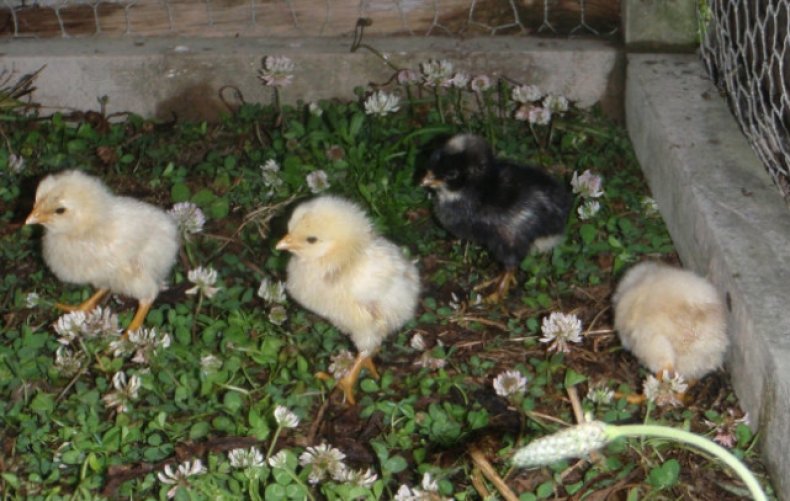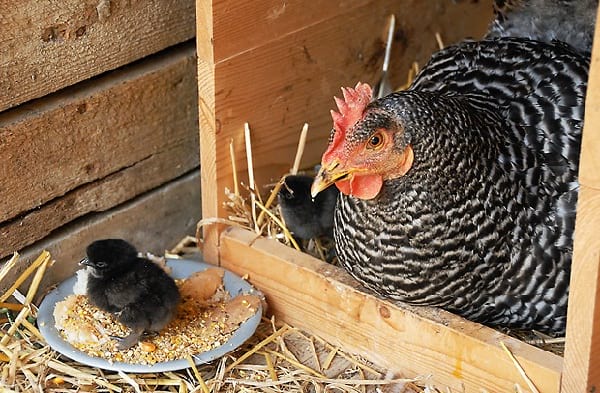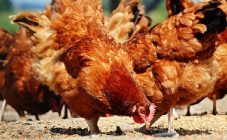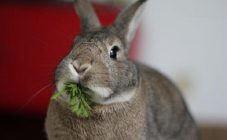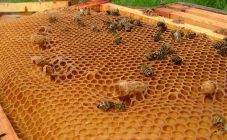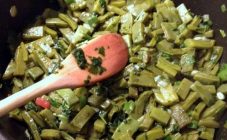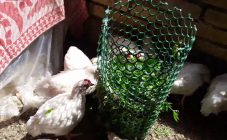Improper chick feeding is the most common mistake novice poultry breeders make. The future growth and development of babies depend on the food received at the beginning of life. The inclusion of prohibited foods on the menu leads to the death of the entire brood.
Chick feeding rules
The diet of chickens changes rapidly as they grow. The poultry farmer must study in advance the set of necessary products and prepare for the preparation of a variety of feeds. Then strong and healthy chickens will grow out of the chicks.
The first food is given to babies on the day they hatch from the egg. The supply of nutrients obtained from the yolk is enough for about 5-6 hours. After that, the chicks must be fed.
To understand whether a particular product can be given to chickens, one should observe the behavior of the laying hen. In the first hours, she takes the kids for a walk. Here they find insects, seeds and fresh herbs. A person makes up a diet, bringing it as close as possible to natural. In this case, the menu is adapted to the still fragile organism.
Seeds are replaced with cereals: semolina, oatmeal or millet. Insects are protein foods and a source of energy. Instead they give:
- cottage cheese;
- low-fat kefir;
- whey and other fermented milk products.
Newborn chickens are given cereals and cottage cheese. Add yolk if desired. All components are thoroughly kneaded to form a crumbly mass. It pecks easily and is well digested by the child's body.
The number of components per 10 chicks should be as follows:
- yolk - 1 pc .;
- cottage cheese - 3 tbsp. spoons;
- groats - 2 tbsp. spoons.
Laying hen teaches cubs to peck food. Incubator babies have problems with this. The poultry farmer should show them what to do - knock the tip of the knife on the feed, raise and lower the piece.
The compound feed is easy to prepare yourself. This will require:
- corn - 3 tbsp.
- wheat and cake - 1 tbsp.
- kefir with a small% fat content - 0.5 tbsp.
All components are mixed and ground. This will make the feed easier for chicks to digest. The result is 1 kg of the finished mixture.
Further, the frequency of feeding is reduced, leaving equal intervals of time between meals:
- from 11 to 30 days 6 times a day;
- from 1 to 2 months 4 times a day;
- from 2 months 3 times a day.
In the first week, the menu is diluted with herbs. It is finely chopped to make it easier for babies to peck. The herb provides the body with useful elements.
From day 8, a little yeast is added to the feed. They accelerate growth and muscle gain. They are added to the general mash - for 10 chicks 1 tsp. Yeast fungi have a positive effect on the digestive tract.Bread also contains this component, but it is more difficult for babies to digest it, so it is poorly absorbed. As an exception, it is sometimes allowed to add crumbs.
In the menu of two-week-old chicks, fish is introduced. It is put in a mash made from vegetables, cereals, fresh herbs and dairy products.
Over time, instead of compound feed, they begin to give bran. Calcium supplements should also be included. They are sold in specialized stores.
Monthly birds are taken for walks. If this is not done, then they will develop vitamin deficiency. Sunlight stimulates the production of vitamin D.
On the street, they themselves bite insects and greens - this is a good addition to the main diet.
The mash continues to give as usual. They consist of:
- vegetables;
- fermented milk products;
- croup.
At this age, coarse grains are included. As the chicks grow, it is replaced with a whole one. Gravel or shell rock is poured into separate feeders. It is forbidden to give sand - it clogs the goiter and esophagus.
At 3 months, the birds are transferred to feed for adult chickens. But the portions should be large, as the body continues to develop, so it needs more nutrients. It is allowed to give the remains of human food as an additive to the diet - bread, meat trimmings, fish.
Dos and Don'ts of Chickens
Poultry farmers often have difficulty choosing which foods to feed their chickens. The most common questions are listed in the table.
| Is it possible to give dill to chickens | Greens are a source of vitamins, they must be included in the menu for 3-4 days. Chickens happily eat both dill and grain and legumes: dandelion, plantain, knotweed, woodlice, clover, nettle, quinoa, sorrel, parsley, green onions, lettuce and duckweed. Prohibited herbs - cheremitsa, hemlock, cockle, spurge, celandine, buttercup, yarrow, black nightshade, potato and tomato tops, burdock, horse chestnut, white acacia, juniper, elderberry. In winter, when there is no fresh greens, the chickens are given sprouted grain, for example, barley. |
|---|---|
| Is it possible to give serum to chickens | Fermented milk products are extremely beneficial for babies. They provide the body with essential probiotics, calcium and protein. Milk whey is given already for 2-3 days. |
| Is it possible to give raw millet to chickens | Raw millet is rich in protein, which is a building block for muscle tissue. The product is included in the menu on the second day after birth. Millet grains are pre-steamed to make them easier for the young body to digest. You should not give boiled millet porridge. Excessive starch causes the beaks to stick together. |
| Is it possible to give rolled oats to chickens | Milled rolled oats are introduced on the second day. It is added to the mash. |
| Is it possible to give semolina to chickens | Semolina, like rolled oats and millet, are given to babies on the second day of life. |
| Is it possible to give bread to monthly chickens | It is at this age that it is allowed to introduce a small amount of bread into the diet. It provides additional energy and accelerates muscle gain, which is especially important for broilers. It is given separately or added to wet mash. However, excess food leads to obesity and indigestion. The maximum portion is 40% of the daily ration. But there should be no additives in the bread: flavorings, spices or oils. |
| Is it possible to give milk to chickens | Powdered milk is a part of compound feed, it is also put into home mash. Chicks should not be given fresh fresh milk. Their stomachs aren't ready to digest it yet. Lactose intolerance can kill the entire brood. Skimmed or powdered milk is given on the 5-6th day of life. Add 200-300 ml per 1 kg of feed. It is better to pay attention to fermented milk products - cottage cheese, kefir, yogurt. They are given to babies from birth. |
In addition to those shown in the table, some other foods that chickens must eat are also important.
- Wheat and barley are given to babies from birth. Corn grits are also good for them. It is quite nutritious and small, so it is easy for chicks to peck at it.
- Chickens are also given other types of cereals. In addition to rolled oats, millet and semolina, barley groats and millet have proven themselves well. The norm on the first day is 2 g per individual, after 7 days - 3 g. Buckwheat and rice can be present in the diet, but in strictly limited quantities.
- Egg white is injected for 3-4 days. At the same time, the shell is added. Previously, the film is removed from it and pounded. It provides the body with calcium, which is necessary for the formation of the skeleton.
- On the 5th day, add cabbage. So that babies do not have stomach irritation due to the abundance of fiber, it is rubbed on a fine grater and added to compound feed.
Another important component of chicken nutrition is peas. It contains lysine. It is an essential amino acid that is not produced in the body and must be supplied with food. She is responsible for the flow of many processes:
- protein synthesis;
- the formation of skeletal tissues;
- the production of enzymes and hormones;
- absorption of calcium;
- the work of the immune system.
Peas are carefully introduced into the menu on day 8, after being chopped. First, a small amount is added so that the specific smell does not scare off the chickens. Then the portion is brought to 10-12% of the total weight of the feed.
Boiled vegetables are fed to 10-day-old chickens. The most useful are the following:
- carrots - a source of carotene, polysaccharides, valuable minerals and dietary fiber;
- pumpkin - rich in carotene, potassium, ascorbic acid, phosphorus and other essential substances;
- potatoes - provides babies with energy, because they contain a lot of carbohydrates and starch. Vitamins A and C accelerate weight gain. Throw away potato peels. They are of no use;
- zucchini - introduced into the menu of chickens over 3 weeks old as an addition to the main menu. If you give too many of them, then digestion is upset in birds. Zucchini is chopped on a grater, mixed with grain and infused for a couple of hours. The feed is saturated with juice and is better absorbed.
The amount of vegetables in the diet increases with age:
- from 10 to 30 days - 5 g per individual;
- from 30 days to 3 months - 10 g;
- over 3 months - 100 g.
If you follow the recommendations, then the birds will grow up healthy. Strong immunity will protect them from disease.
Nutrition Tips and Tricks for Day-old Chicks
Experienced poultry farmers advise observing the following guidelines for feeding newborn chicks:
- The feeder should be only one third full to prevent chicks from scattering food. You can cover it with a grid with large holes. Then the chicks will not get into the food with their paws.
- If the chicken does not fit the food on its own, it is fed separately from a pipette with low-fat kefir and egg yolk until it gains strength.
- Chicks should always have clean and fresh water nearby.
- Once every 3 days, the chickens are given a saturated solution of potassium permanganate. It kills disease-causing bacteria and prevents disease from developing.
- The feeder is washed regularly, and after each feeding, food debris is removed so that they do not deteriorate. Disinfection is carried out with 5% formalin solution or hot water and soap.
Proper nutrition is the key to healthy chickens. The feed should provide them with the necessary proteins, fats, carbohydrates, vitamins and minerals. Then they will quickly grow up and not get sick.

